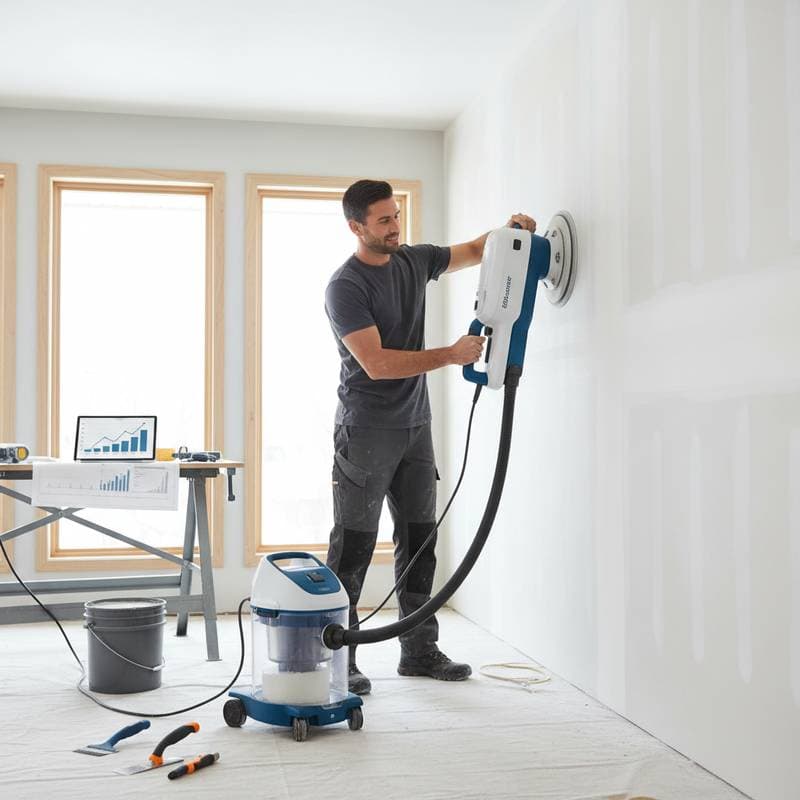The $800 Dustless Sander Everyone Swears By for Drywall
A smooth, perfectly prepped drywall surface transforms the final appearance of any room. Traditional sanding methods generate clouds of dust that settle on floors, furniture, and air ducts for days. Professionals and homeowners increasingly rely on the $800 dustless sander for drywall finishing. This tool integrates advanced suction technology with efficient sanding capabilities to deliver clean results and accelerate project timelines.
Knowledge of costs, benefits, and influencing factors equips homeowners to plan projects effectively. Decisions about purchasing equipment or hiring contractors become clearer with this understanding.
Factors Affecting Dustless Drywall Sanding Costs
Multiple elements determine the overall expense of dustless drywall sanding. Awareness of these components enables more precise budgeting for homeowners.
Equipment Quality
The $800 dustless sander represents professional-grade performance with integrated high-efficiency dust extraction. Budget models often feature weaker suction or less durable parts, which prolong tasks or permit residual dust. Selection of superior equipment enhances outcomes and shortens project durations.
Surface Condition
Walls bearing several layers of joint compound, irregular seams, or prior paint applications demand extended sanding efforts and elevated labor fees. Drywall with minimal finishing completes more quickly, thereby reducing both time and expense.
Access and Room Layout
Confined corners, overhead ceilings, and staircases present added challenges. Contractors apply premium rates to such areas due to the necessity for prolonged effort and enhanced safety protocols.
Filtration and Containment Setup
Effective dustless operations depend on vacuum filtration systems. HEPA filters paired with airtight hoses promote superior air quality, though they necessitate regular upkeep and periodic replacement to manage incremental expenses.
Regional Labor Rates
Hourly wages vary by geographic region. Metropolitan zones with elevated cost of living typically command higher rates, whereas rural locales provide more economical options, albeit with potentially limited access to expert services.
Cost Breakdown for a Medium Room
For a 400 square foot drywall area, anticipate total costs ranging from $700 to $1,400.
- Basic sanding and labor: $400 to $800
- Equipment use or rental: $150 to $250
- Surface preparation and masking: $50 to $150
- Cleanup and inspection: $100 to $200
These figures encompass labor and materials for routine drywall finishing, yielding a paint-ready smooth surface. Extensive repairs or ceiling applications may inflate expenditures.
Value and Return on Investment
The dustless drywall sander extends beyond mere convenience. It provides tangible advantages through improved air purity and diminished cleanup requirements. Contractors benefit from expedited workflows and heightened client approval. Homeowners experience reduced post-project tidying and minimized health risks from airborne particles.
The $800 initial outlay appears substantial, yet it yields returns across successive endeavors. Daily rental fees for such sanders span $50 to $100, allowing frequent users to recoup the investment after a handful of applications. Pristine finishes further avert the need for revisions or paint adjustments, curtailing future labor outlays.
Money-Saving Strategies
Homeowners can curb drywall sanding expenses through targeted approaches while upholding superior finish standards.
- Prepare the area in advance. Dismantle fixtures, shield floors, and secure edges prior to contractor arrival. This reduces setup duration and associated charges.
- Integrate sanding with complementary drywall procedures. Contractors frequently propose discounted packages that encompass taping, mudding, and sanding.
- Schedule during low-demand periods. Renovation services encounter seasonal lulls, prompting providers to extend reductions or adaptable timetables.
- Apply appropriate grits and methods. Excessive sanding depletes supplies and extends timelines. Sequential grit advancement yields optimal efficiency and superior results.
- Service sander filters routinely. Maintained filtration preserves vacuum potency, preventing premature wear or compromised environmental control.
Planning Your Budget
Structured planning harmonizes quality with fiscal constraints. Begin by calculating the aggregate square footage of walls and ceilings, then apply the prevailing cost spectrum. Incorporate a 10 to 15 percent contingency allowance for unforeseen complications, such as fissures or compound variances.
Solicit detailed quotations that delineate labor, supplies, and machinery fees. Such specificity facilitates value assessment beyond mere price comparison. Providers employing dustless systems typically embed cleanup provisions, mitigating the premium for advanced tools.
For self-directed sanding, weigh rental against acquisition. Short-term rentals suit isolated undertakings economically. Ownership proves advantageous for repeated applications, fostering sustained savings.
Professional vs DIY Dustless Sanding
Professional services guarantee uniform, expedited, and dust-minimized outcomes. Experts navigate complexities with precision, ensuring compliance with building norms.
DIY efforts suit minor corrections or solitary spaces, offering cost reductions through personal labor. Success demands dedication, skill development, and access to robust tools. Entry-level dustless sanders prove more affordable but often insufficient for comprehensive dust capture, potentially leading to incomplete results.
Getting Started with Your Project
Select a sanding system that aligns with project scope to establish a foundation for efficient, mess-free renovations. The $800 dustless sander supports professional-caliber finishes for both homeowners and tradespeople. Initiate by evaluating space dimensions and surface states to inform equipment and service choices.
Frequently Asked Questions
What is the average cost for dustless drywall sanding?
Most projects incur $1.50 to $3.50 per square foot, covering labor and materials. Scope, substrate quality, and locale modulate the aggregate sum.
What factors have the biggest impact on sanding costs?
Prominent influencers encompass substrate readiness, site accessibility, tool caliber, and prevailing wages. Substandard drywall or elevated structures necessitate augmented time and apparatus.
How can I save money on dustless sanding without losing quality?
Pre-arrange the workspace, align timing with off-peak availability, and pursue integrated service bundles. Vigilant equipment care further trims enduring expenses.
Should I hire professionals or attempt this as a DIY project?
Professionals furnish reliable, swift execution with minimal disruption. DIY conserves funds for modest scopes but demands substantial time investment and tool procurement.
How do I budget for unexpected costs in drywall sanding?
Reserve 10 to 15 percent of estimates for anomalies like irregularities or supplementary applications. Itemized bids from providers aid in forecasting and containment.
When is the best time to start a dustless drywall sanding project for lower costs?
Off-season initiation capitalizes on reduced demand, yielding preferential rates and scheduling latitude from service providers.



